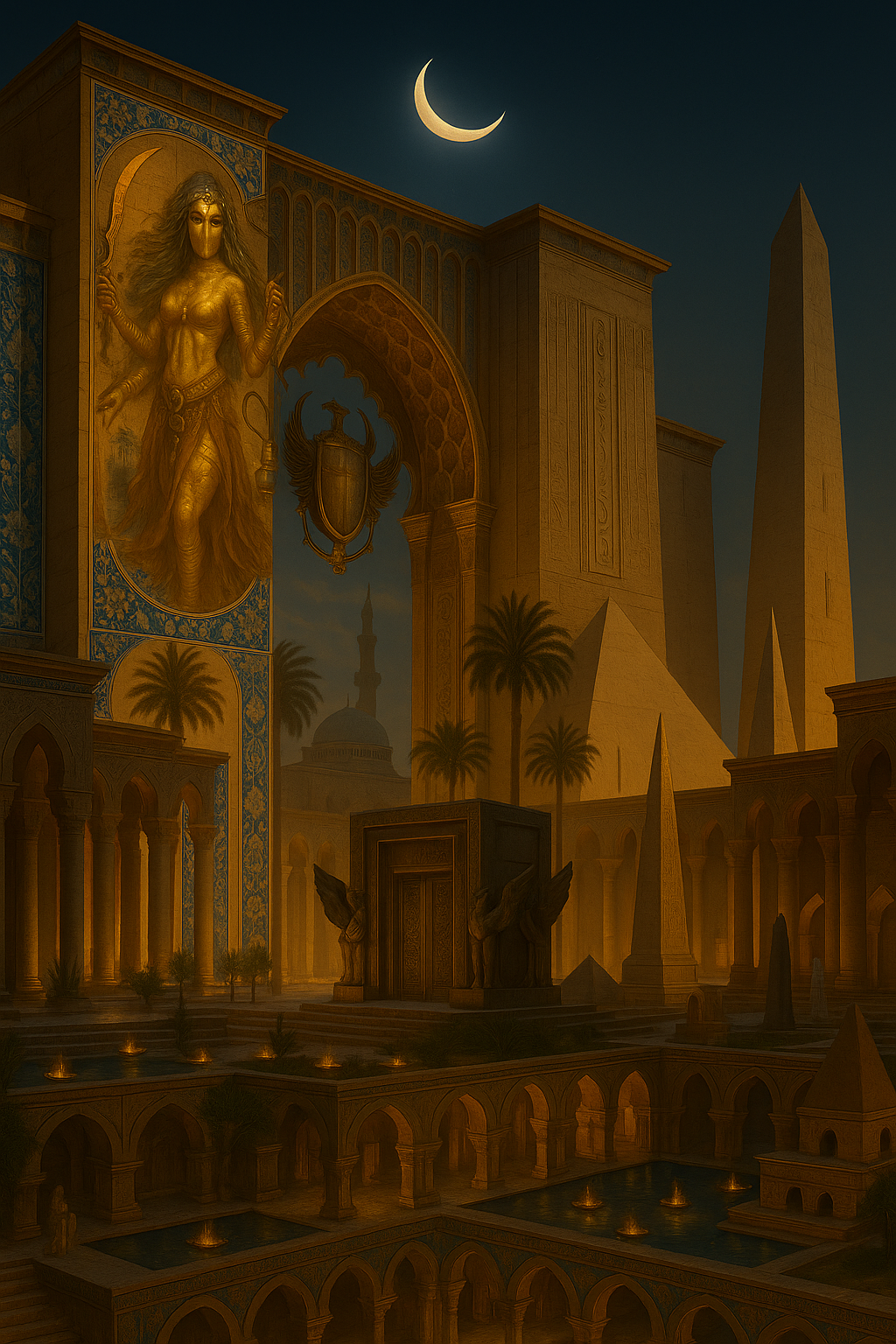Het-netjer of Sharadiya
Purpose / Function
This building houses the priesthoods of Sharadiya, The Golden Tear. This complex houses 4 of the priesthoods where each practice their goals and tenets.
Architecture
The Het-netjer of Sharadiya rises like a dream of sun-baked stone and gold, a fortress of the divine where Sharadiya's goals and tenets are lived out beneath the crescent moon.
The outer walls are sheer and massive, carved with towering hieroglyphs—not just inscriptions, but a great, looming figure of Sharadiya The stone is honey-colored, warm as a desert wind, but at certain angles, the light catches veins of lapis lazuli, glinting like scattered stars.
The gateway is a colossal pylon, but instead of the traditional Egyptian double-tower, it arches upward into a pointed muqarnas vault, its niches dripping with stone stalactites that shimmer with gold leaf. Between the pylon’s arms hangs a massive bronze Scarab, in mid flight, its surface etched with prayers in both hieroglyphs and flowing calligraphy.
Beyond the gate, the courtyard is a forest of columns—some thick and lotus-crowned like Karnak’s, others slender and ribbed like the piers of a grand mosque. Their shafts are carved with intertwined serpents and vines, coiling up toward capitals that bloom into stone palm fronds or unfold into eight-pointed stars. The shadows between them are deep, striped with bars of light from high, narrow windows covered in alabaster screens, diffusing the sun into a milky glow.
At the heart of the temple, the sanctuary is a cube of black basalt, its entrance flanked by two obsidian Djinn statues—human-faced, winged, their eyes inlaid with carnelian. The doors are bronze, worked with a thousand eyes, their pupils made of silver. Inside, the air is thick with incense, swirling in shafts of light from a central oculus—a perfect circle open to the sky, ringed by a frieze of winged sun disks and Quranic verse in gold.
The altar is a block of polished red porphyry, veined with white like a bolt of lightning. Above it hangs a golden lamp, shaped like the sun disk of Ra but inscribed with the Ninety-Nine Names of Djinn, its light flickering over walls painted with scenes of judgment Surrounding the main court are four quadrants. One has an open court of sandstone itself divided into four sections. One has a dome that covers its quadrant. One has a Pyramid that rises from its quadrant. and the last has a large Obelisk rising from its center.
And everywhere, there is water—not the still pools of an Egyptian temple, but the murmur of fountains channeled through geometric runnels, their surfaces shimmering with floating lotus candles, their sound blending with the low chant of priests in linen robes and turbans, their voices rising and falling like the Nile’s tide.
It is a place where time bends. Where the desert’s silence meets the echo of prayer.
The Temple Layout
1. The Wind Court (Entrance)
Purpose: Public rituals, trials, and wind-divination.
Design: A vast, roofless plaza of polished sandstone, etched with directional sigils to read the desert’s will.
Feature: The Golden Scarab Altar, where names of the newly dead are whispered into embers, carried skyward by heat.
2. The Silent Sanctum (Shemsu-Sedjemhet)
Purpose: Communion with ancestors and the Mirage Codex.
Design: A sunken, circular chamber beneath the temple, accessible only by a wind-carved staircase. The walls are lined with bone-filled niches (not for burial—bones are ground into ritual dust after Wandering Tributes).
Ritual Focus: The Veil of the Unseen, a cloth woven from sand-scoured linen that moves without touch.
3. The Djinn Forge (Shemsu-Hekau)
Purpose: Binding and bargaining with spirits.
Design: An open-air furnace where glass blades are forged in djinn-fire. Chains hang from the ceiling—not to imprison, but to weigh promises (each link is a vow).
Ritual Focus: The Blood-Oath Anvil, where pacts are signed in burns, not ink.
4. The Four Pillars Arena (Shemsu-Nisut)
Purpose: Trials of strength and grace.
Design: Four monolithic pillars surround a sandpit. Fighters duel here, their shadows cast against the pillars as living hieroglyphs.
Ritual Focus: The Phantom Gauntlets, left on the sand each night—if moved by dawn, Sharadiya has blessed the grounds.
5. The Mirage Archive
Purpose: Houses the living Mirage Codex.
Design: A tower with slatted walls, allowing sand to etch and rewrite prophecies onto parchment. No doors—priests enter by climbing wind-ladders (ropes that sway like storm-tossed reeds).
Ritual Focus: The Ink of Echoes, made from ground lapis and ghost-ash, used to transcribe the wind’s words.
Type
Temple / Religious complex
Parent Location
Owning Organization




Comments